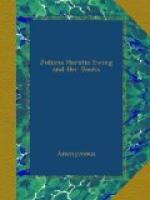[Footnote 18: The drawing, with whatever temporary purpose executed, is for ever lovely; a thing which I believe Gainsborough would have given one of his own pictures for—old-fashioned as red-tipped daisies are, and more precious than rubies.—Ruskin, “Notes on some of the Pictures at the Royal Academy.” 1875.]
[Footnote 19: Published by the Fine Art Society, Bond-street.]
The scene of the little girls in beaver bonnets was really taken from an incident of Julie’s childhood, when she and her “duplicate” (my eldest sister) being the nearest in age, size, and appearance of any of the family, used to be dressed exactly alike, and were inseparable companions: their flat-irons, I think, were bought in Matlock. Shadowy glimpses of this same “duplicate” are also to be caught in Mrs. Overtheway’s “Fatima,” and Madam Liberality’s “Darling.” When “A Flat-Iron” came out in its book form it was dedicated “To my dear Father, and to his sister, my dear Aunt Mary, in memory of their good friend and nurse, E.B., obiit 3 March, 1872, aet. 83;” the loyal devotion and high integrity of Nurse Bundle having been somewhat drawn from the “E.B.” alluded to. Such characters are not common, and they grow rarer year by year. We do well to hold them in everlasting remembrance.
PART II.
The meadows gleam with hoar-frost
white,
The day breaks on the hill,
The widgeon takes its early flight
Beside the frozen rill.
From village steeples far away
The sound of bells is borne,
As one by one, each crimson ray
Brings in the Christmas morn.
Peace to all! the church bells say,
For Christ was born on Christmas day.
Peace to all.
Here, some will those again embrace
They hold on earth most dear,
There, some will mourn an absent face
They lost within the year.
Yet peace to all who smile or weep
Is rung from earth to sky;
But most to those to-day who keep
The feast with Christ on high.
Peace to all! the church bells say,
For Christ was born on Christmas day.
Peace to all.
R.A. GATTY, 1873.
During 1871, my sister published the first of her Verses for Children, “The Little Master to his Big Dog”; she did not put her name to it in Aunt Judy’s Magazine, but afterwards included it in one of her Verse Books. Two Series of these books were published during her life, and a third Series was in the press when she died, called “Poems of Child Life and Country Life”; though Julie had some difficulty in making up her mind to use the term “poem,” because she did not think her irregular verses were worthy to bear the title.
She saw Mr. Andre’s original sketches for five of the last six volumes, and liked the illustrations to “The Poet and the Brook,” “Convalescence,” and “The Mill Stream” best.




